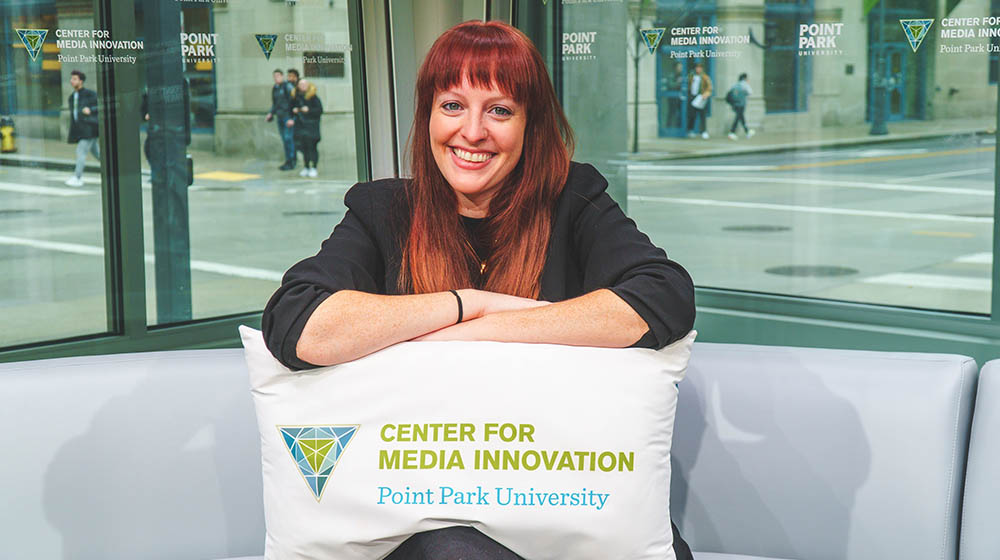Doris O'Donnell Winner Erica Hensley Visits Campus to Work on Fellowship Project, Meet with Environmental Studies and Journalism Students Thursday, February 13, 2020

Erica Hensley, an investigative reporter for Mississippi Today, and the inaugural winner of the Center for Media Innovation's Doris O'Donnell Innovations in Investigative Journalism Fellowship, visited Point Park University Jan. 27-31. During her trip, she worked on her fellowship project and met with environmental studies and journalism classes.
"The Center for Media Innovation is such a beautiful space and powerful resource for students, reporters and just the city itself, really. I’m honestly a little jealous for younger Erica, wishing I had had a resource like this in college. It’s great to see students embracing true multimedia storytelling through multiple platforms. It’s the only way news media will survive as we know it."
Briefly highlight your career path.
I had the unfortunate luck of graduating college in 2008 when news media was entering crisis mode due to the recession and majorly shifting news dissemination models. That timing really forced me to get creative because the traditional path to print journalism I had prepared for was off the table. I ended up freelancing for a decade in Atlanta, which was a great way to network and tell the stories I was passionate about – but that came with a lot of hustling, too. I knew I wanted to segue back to a newsroom, so I buttressed my reporting and writing skills with a health and medical journalism master’s degree that really informed my path moving forward. Almost every story is a health story in some way, and thinking about investigations through that lens has helped me chart my own investigative health beat across Mississippi.
What did receiving the Doris O’Donnell Innovations in Investigative Journalism Fellowship from the Center for Media Innovation at Point Park University mean to you and the work you do?
I can't overstate how important it has been. Mississippi Today is a non-profit fully digital state-wide newsroom that’s completely free to readers, so we are really shaking up the traditional news model. But with that, we have to rely on diverse revenue streams. We don’t have subscriptions or circulation, so we are funded through fellowships, grants and donors. As the only fully staffed newsroom covering the whole state, the deep-dive stories we tell would likely go untold without our reporting.
Tell us about your project.
Lots of data! My project is a great example of stories that would otherwise go untold. I’m looking at lead exposure across the state and identifying pockets of risk. Because Mississippi is a bit of “data desert” with regard to some public health problems, there isn’t comprehensive data about where children are most susceptible to lead. To combat that, I’m extracting data where I can, overlapping datasets and identifying that risk myself. Lead exposure usually happens three ways: water, paint or soil/dust. I’m tracking all three exposures and layering the information to map risk pockets.
What was it been like spending a week at Point Park University in January?
It was great! The CMI is such a beautiful space and powerful resource for students, reporters and just the city itself, really. I’m honestly a little jealous for younger Erica, wishing I had had a resource like this in college. It’s great to see students embracing true multimedia storytelling through multiple platforms. It’s the only way news media will survive as we know it. I was trained, not very long ago, to think of news in silos: “print,” “broadcast,” and a little bit of “online.” Those lines are blurred more than ever and students need to not only be comfortable in all three, but need to be able to merge them for digital storytelling. It’s great to see a place for young journalists that embraces that.
As part of your fellowship, you had the opportunity to work with our students in class with Professors Matthew Opdyke, Ph.D., and Bill Moushey, M.S. What were some of your key messages to the environmental studies and journalism classes?
The message I really try to impart is that every story is a health or environment story. Even if you don’t see the immediate health and medical ramifications – there is likely a long-term health impact. Also, to just be comfortable asking “why?” on a deeper level and looking toward solutions. What are the social determinants of this situation? What powers that be stand to benefit from keeping the status quo and who’s working on changing it? It’s not enough anymore to just point to the problems – there are too many. I think it’s beholden on journalists to focus on answers, where possible, and explore what’s working as well.
What was it like working with our students?
I hope they’ve gleaned something from it. It can be hard to gauge impact on students, but if after I leave they have one more data skill in their reporting toolbox, or can think a little more creatively about how to collect and visualize data, then I’ll be happy.
Is there anything else you would like to add?
Just how thankful I am for the opportunity and to be working with the great folks at CMI. Lead exposure cannot be reversed and the damage is permanent. This grant gave Mississippi Today the dedicated resources and long runway, which a story like this requires, to tell an important story and give Mississippians in under-resourced (for news, and otherwise) communities the information they deserve to effect change and advocate for healthier homes and lives.
Photo by Emma Federkeil, broadcast production and media management major

